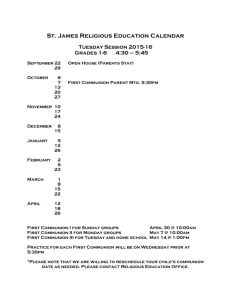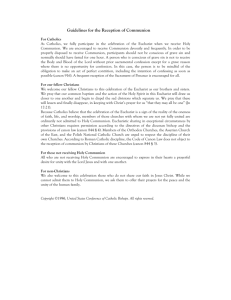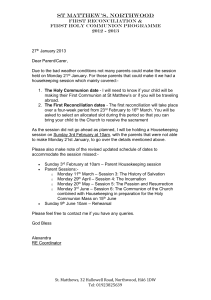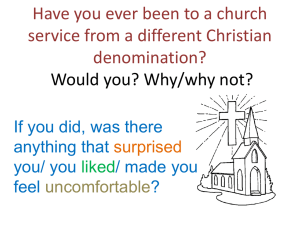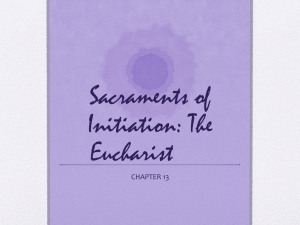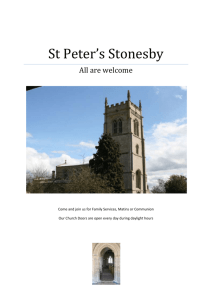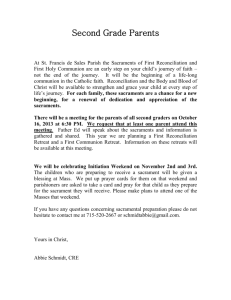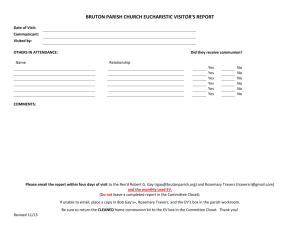Extra Ordinary Ministers of Holy Communion Handbook
advertisement
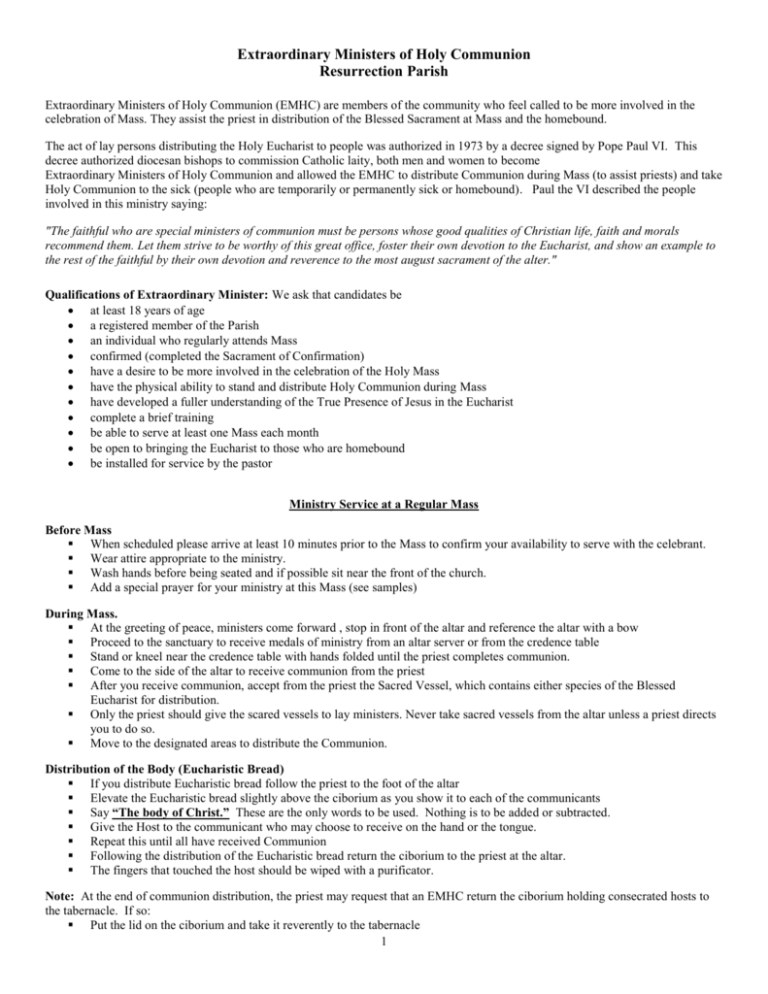
Extraordinary Ministers of Holy Communion Resurrection Parish Extraordinary Ministers of Holy Communion (EMHC) are members of the community who feel called to be more involved in the celebration of Mass. They assist the priest in distribution of the Blessed Sacrament at Mass and the homebound. The act of lay persons distributing the Holy Eucharist to people was authorized in 1973 by a decree signed by Pope Paul VI. This decree authorized diocesan bishops to commission Catholic laity, both men and women to become Extraordinary Ministers of Holy Communion and allowed the EMHC to distribute Communion during Mass (to assist priests) and take Holy Communion to the sick (people who are temporarily or permanently sick or homebound). Paul the VI described the people involved in this ministry saying: "The faithful who are special ministers of communion must be persons whose good qualities of Christian life, faith and morals recommend them. Let them strive to be worthy of this great office, foster their own devotion to the Eucharist, and show an example to the rest of the faithful by their own devotion and reverence to the most august sacrament of the alter." Qualifications of Extraordinary Minister: We ask that candidates be at least 18 years of age a registered member of the Parish an individual who regularly attends Mass confirmed (completed the Sacrament of Confirmation) have a desire to be more involved in the celebration of the Holy Mass have the physical ability to stand and distribute Holy Communion during Mass have developed a fuller understanding of the True Presence of Jesus in the Eucharist complete a brief training be able to serve at least one Mass each month be open to bringing the Eucharist to those who are homebound be installed for service by the pastor Ministry Service at a Regular Mass Before Mass When scheduled please arrive at least 10 minutes prior to the Mass to confirm your availability to serve with the celebrant. Wear attire appropriate to the ministry. Wash hands before being seated and if possible sit near the front of the church. Add a special prayer for your ministry at this Mass (see samples) During Mass. At the greeting of peace, ministers come forward , stop in front of the altar and reference the altar with a bow Proceed to the sanctuary to receive medals of ministry from an altar server or from the credence table Stand or kneel near the credence table with hands folded until the priest completes communion. Come to the side of the altar to receive communion from the priest After you receive communion, accept from the priest the Sacred Vessel, which contains either species of the Blessed Eucharist for distribution. Only the priest should give the scared vessels to lay ministers. Never take sacred vessels from the altar unless a priest directs you to do so. Move to the designated areas to distribute the Communion. Distribution of the Body (Eucharistic Bread) If you distribute Eucharistic bread follow the priest to the foot of the altar Elevate the Eucharistic bread slightly above the ciborium as you show it to each of the communicants Say “The body of Christ.” These are the only words to be used. Nothing is to be added or subtracted. Give the Host to the communicant who may choose to receive on the hand or the tongue. Repeat this until all have received Communion Following the distribution of the Eucharistic bread return the ciborium to the priest at the altar. The fingers that touched the host should be wiped with a purificator. Note: At the end of communion distribution, the priest may request that an EMHC return the ciborium holding consecrated hosts to the tabernacle. If so: Put the lid on the ciborium and take it reverently to the tabernacle 1 Close the door an turn the key to lock the tabernacle Leave the key in the tabernacle at this time Genuflect in front of the tabernacle Join the other EMHC near the credence table. Distribution the Precious Blood (Eucharistic Wine) If you distribute Precious Blood take the cup and purificator and move to the traditional distribution area. Elevate the cup slightly to each of the communicants saying “The blood of Christ.” These are the only words to be used. Nothing is to be added or subtracted. Hand the communicant the cup, taking care to keep hands near the cup o Note: for some with unsteady hands or young children you may need to keep your hands on the cup and help the communicant receive. After the Blood of Christ has been received, wipe the rim of the sacred cup, inside and out, with a purificator. The EMHC should be careful not to wipe in a manner where the purificator is dipped into the Precious Blood Rotate the cup slightly in your hand before giving to the next communicant Try to use a different spot on the purificator each time you wipe the cup Repeat this until all have received Communion or until your cup is empty Following the distribution of the Precious Blood return the cup to the credence table. Any remaining Precious Blood must be consumed by an EMHC or the priest. If none remains the minister should cover the cup with the purificator. Do not wipe out the cups. Sacred vessels are to be purified by a priest, deacon or acolyte. They may do this at the Mass or immediately after. Once the vessels are purified, they may be sanitized by anyone in preparation for the next Mass. Returning to Seats Remove the medal of ministry and place it on the table. Together move to the front of the altar and reference the altar with a bow Return to your seat for the conclusion of Mass. 2 Ministry Service for the Sick and/or Homebound The Distribution of Communion to the Sick and Homebound: The act of lay persons bringing the Eucharist to people who are temporarily or permanently sick or homebound is a ministry that was authorized in 1973. This decree, signed by Pope Paul VI, authorized laymen and women to become extraordinary ministers. This decree, of course, included visiting and taking the Eucharist to the homebound/shut-ins. The following additional norms are to be followed for Extraordinary Ministers of Holy Communion who will take Communion to the sick and homebound. 1. 2. 3. 4. 5. 6. 7. 8. 9. 10. 11. 12. 13. This is to be considered a special and distinct ministry over and above that of Extraordinary Ministers of Holy Communion who will function within Mass. Extraordinary Ministers of Holy Communion who will take Communion to the sick and homebound should be taught to see their role as sharing in the Church’s total ministry to the sick and the poor after the manner of Jesus. These should be persons who can minister with compassion and understanding. Those who will serve in this way are to be made aware of the particular obligation to respect the confidences of persons to whom they minister. These extraordinary ministers should be given proper instruction with regard to reverence in carrying the Holy Eucharist and to performing the ritual prescribed for distribution of Communion to the Sick They should perform their ministry without visiting with others or engaging in other activities. The sick and homebound persons should be assured of the meaning and value of this ministry. It would be well to personally introduce extraordinary ministers to sick and homebound persons before their ministry to them. It must be stressed that the ministry of Extraordinary Ministers of Holy Communion is not to replace the ministry of the priest to his people, but is rather to extend and expand it so that all will have more regular contact with Christ in the Eucharist. The pastor should see that worthy Eucharistic containers are available for use by extraordinary ministers to the sick and homebound. The Host is not to be carried in a handkerchief, envelope or similar unworthy container. It is recommended that Hosts for the sick and homebound be consecrated in the Mass from which they will be taken and in which the extraordinary ministers have participated. In this case, there are a number of options: a. Immediately before receiving Communion themselves, extraordinary ministers may receive their Hosts for distribution b. After distribution of Communion to the assembly, and before the Prayer after Communion extraordinary ministers may come forward to receive their Hosts for distribution. c. During the Communion rite, the Hosts for distribution to the sick and homebound may be put into Eucharistic containers which are then placed in the tabernacle until after Mass when the ministers may pick them up. In whatever approach, ministers should go directly to their ministry without greeting others or socializing after Mass. Hosts which cannot be distributed immediately and consumed at once by the sick and homebound should be consumed by the minister or returned to the tabernacle. They should not be left to be received at a later time, carried around while doing other business, or kept in the car or home of the minister. The service of Extraordinary Ministers can be of significant assistance to the pastor and parish in taking the Holy Eucharist to those unable to be present for Mass. In bringing communion to them the Minister of Communion represents Christ and manifests faith and charity on behalf of the whole community toward those who cannot be present at the Mass. For the sick the reception of communion is not only a privilege but also a sign of support and concern shown by the Christian community for its members who are ill. Before Visiting Collect information about the person who is sick and other helpful information for your visit to the home or hospital. Make an appointment to visit. Ask how the person is feeling and if there will be others present so you will have sufficient hosts for all to receive. Also ask if they can prepare a table with a cloth, candle, cross or crucifix. Carry the host in a pyx. Have respect and reverence for the presence of Christ. When transporting the Eucharist to the sick, ministers should avoid any activity not in keeping with the reverence due to the Blessed Sacrament. Wear attire appropriate to the ministry. Know that the relationship with the person who is sick is a key factor. The minister brings the comfort and concern of Christ. Be aware of feelings that may arise when you enter a person’s home or room – the person’s appearance, hospital equipment, the environment. When it is difficult to look at the person because of their physical condition, concentrate on their eyes. Take proper time for introduction and personal sharing. Listen attentively. If you are uncertain or suspect sensitive conditions, check with the family or the nurse for more information. Be sensitive to feelings of loneliness and depression. Consider the situation and desires of the person who is sick and make decisions based on this information before beginning the Communion Rite. Be prepared in the face of refusal or rejection by either the person who is sick or by a family member. Be ready to offer modified services in such cases. 3 If the person does not wish to share Communion at this time, ask if they would like to share in a short blessing prayer. Be aware of making referrals when other services are needed. (Confessor, counselor, doctor, etc.) Do not try to solve problems. If the sick wish to celebrate the sacrament of penance, encourage them or the family to be in contact with the parish priest. You might also offer to relay the message yourself. Keep confidences at all times. Prayer of a Minister of Communion to the Sick and Homebound My heavenly Father and Sustainer of All, I am in your Sacred Presence about to take the Bread of Life to those who are unable to attend the communal celebration of the Eucharist. It will be my honor to carry the Bread of Life to them. Bless my hands that they may be fitting instruments of this Holy visitation. Bless my heart that I may truly carry the Bread of Life to those whose spirits are in need. May my attitude, my reverence and my concern for both the spiritual and material needs of those whom I shall visit be that of Your divine heart. I ask this in the name of our Lord, Jesus Christ, whose Body I shall carry; He who lives with You and the Holy Spirit forever and ever. Amen. As You Begin the Visit Begin informally. Introduce yourself to those who are present and briefly explain what you have come to do. Pay attention to how the sick/homebound person is feeling. Invite those who are present to participate in the prayers. If they feel comfortable, enlist the help of family or friends to do the readings. Create links to the parish, e.g., bring a parish bulletin, share news from the parish, ask if there is anything the parish can do for them, if they need to see a priest for the sacrament of reconciliation or anointing of the sick. Share ideas from the homily/daily readings if appropriate After listening to the conditions and desires of the person who is sick, ask if the person desires Communion at this time. Invite the family to receive Communion if appropriate. The Performing the Rite Pace the ritual with sensitivity. Be aware of the sick person’s ability to follow. Adapt to the situation of each visit. If the family suggests setting a simple table with candles and holy water, agree with this but do not insist upon it when the family is not ready or unfamiliar with the practice. Give a small portion of the host to a person who has difficulty swallowing. Check with the nurse or doctor in cases of special feeding. Wait for the person to swallow the host. Offer water if necessary. Be prepared with a cloth in the event that the person has problems. Take time to pray reverently and to be present with the sick person and the family. Thank the person for the opportunity to pray with them and for their hospitality. Be sensitive to the proper time to depart. Some Don’ts: Don’t visit a sick person if you are not feeling well yourself. Find a substitute. Don’t stay too long or take the role of a counselor or priest. Don’t compete with a television or radio. Politely ask if these can be turned off during the service. Don’t carry the consecrated host in a plastic bag, purse, pocket or other unsuitable container. Instead, use a pyx to carry the consecrated host. Don’t leave the consecrated host if the person cannot receive it. Instead, return at a later time to see the sick person. Consume any consecrated host or return it to tabernacle in the church or hospital chapel. Don’t take hosts home or leave them in your car. 4 The Short Rite of Communion of the Sick/Homebound includes: Introductory Rite Antiphon Penitential Rite/Examination of Conscience Liturgy of Holy Communion Greeting Scripture Reading The Lord’s Prayer Communion Concluding Rite Concluding Prayer Introductory Rite: (It is customary to have a lighted candle and a crucifix near by) Read one of these Antiphons A How holy this feast in which Christ is our food: his passion is recalled; grace fills our hearts; and we receive a pledge of the glory to come. B. How gracious you are, Lord: your gift of bread from heaven reveals a Father’s love and brings us perfect joy. You fill the hungry with good things and send the rich away empty. C. I am the living bread come down from heaven. If you eat this bread you will live for ever. The bread I will give is my flesh for the life of the world. Penitential Rite/Examination of Conscience: Take a moment examine the conscience as they prepare to received the Eucharist. You may use a form such as Christ/Lord have mercy. Liturgy of Holy Communion Greeting: Read one of these greetings A. The peace of the Lord be with you always. B. The grace of our Lord Jesus Christ and the love of God and the fellowship of the Holy Spirit be with you always. Response: And also with you The EMHC places the open pxy on a table and invite all to briefly contemplate the mystery of the Eucharist and offer adoration. Scripture Reading When time permits and the setting is appropriate a scripture reading from the daily readings (may be omitted depending on the situation and time) The Lord’s Prayer: Use one of these introductions to begin the prayer A. Jesus taught us to call God our Father and so we have the courage to say: B. Now let us pray as Christ the Lord has taught us: Our Father, who art in heaven…………………………………………………….. Communion: The EMHC displays the Host and choose one of these introductions A. This is the Lamb of God who takes away the sins of the world. Happy are those who hunger and thirst for they shall be satisfied. B. This is the bread of life. Taste and see that the Lord is good. Response: Lord I am not worthy to receive you, but only say the word and I shall be healed. The EMHC then says “The Body of Christ” and presents the host to the communicant. Concluding Rite: Read one of these Concluding Prayers A. God our Father, you have called us to share the one bread and one cup and so become one in Christ. Help us to live in him that we may bear fruit, rejoicing that he has redeemed the world. We ask this through Christ our Lord, Amen. B. All-powerful and ever-living God, may the body and blood of Christ your Son be for our brothers and sisters a lasting remedy for body and soul. We ask this through Christ our Lord, Amen. 5 C. All-powerful God, We thank you for the nourishment you give us through your Holy Gift. Pour out your Spirit upon us and in the strength of this food from heaven keep us single minded in your service. We ask this in the name of Jesus the Lord Amen. This concludes the Rite. 6 Questions Most Frequently Asked about Taking Communion to the Sick and the Homebound 1. WHEN DO I TAKE COMMUNION TO THE SICK PERSON? It is best to take Holy Communion directly from the community’s celebration of Eucharist in the church to the person in the home. If this is not reasonable, and no substitute is available, please take It as soon as possible, showing respect for the presence of Christ. 2. IF TAKING HOLY COMMUNION IS ONLY PART OF MY VISIT WITH THE SICK OR HOMEBOUND PERSON, SHOULD PRAYER AND COMMUNION BE AT THE BEGINNING OR END OF OUR TIME TOGETHER? There is no set rule but most people find it more comfortable to spend some time in conversation before sharing prayer and Holy Communion. The conversation could include ideas from the homily and reassurance that the parish community prayerfully supports that person. If the sick or homebound person prefers time for private devotion, it is suggested that you visit before prayer and indicate that you will leave immediately after distribution of Communion so as to allow time for quiet reflection and devotion. This respects the privacy of the person while also honoring the importance of communal prayer as part of Eucharist. 3. IF OTHERS ARE PRESENT, SHOULD I INVITE THEM TO PRAY AND RECEIVE COMMUNION WITH THE SICK PERSON? Yes, others should be invited to join in prayer. All Catholics who are participating may be invited to receive Communion. 4. ARE THE SICK OR HOMEBOUND REQUIRED TO FAST AN HOUR BEFORE RECEIVING COMMUNION? No, they may receive Communion at any hour and need not adhere to the normal fasting regulations. 5. WHAT IF THE SICK PERSON IS UNABLE TO SWALLOW THE ENTIRE HOST? Water may be offered to the sick person receiving Communion to aid in swallowing the host. If warranted, just a small portion of the host can be offered if the person is too ill to receive the entire host. The remaining portion of that host must be consumed by someone who is participating in the prayer or by you as minister of Communion. Remember that the divine presence in the Blessed Sacrament is the same regardless of the size of the portion of the host. Consult with the family concerning the condition of the person regarding swallowing. 6. WHAT SHOULD I DO IF THE HOST IS DROPPED OR THE PERSON REMOVES IT FROM HIS/HER MOUTH? If the host is dropped and there are no health concerns, the host may be picked up and consumed. If the dropped host presents health concerns or the person removes the host from his/her mouth, it should be dissolved in water and the water poured into the church sacrarium, not down a drain. Of course, if anyone declines or refuses to receive Communion, you would respect this wish. 7. WHAT DO I DO WITH THE PYX WHEN I AM NOT USING IT TO TAKE COMMUNION TO THE SICK? The pyx should be kept in a safe and respectful place when not in use. Take the pyx to the community’s celebration of Eucharist on the day of visiting the sick. When a minister no longer needs the pyx, it is returned to the parish office or the pastor Miscellaneous Information on the Ministry of Extraordinary Ministers of Holy Communion EMHC’s are members of the community who feel called to be more involved in the celebration of Mass. In 1973, diocesan bishops were authorized to commission Catholic laity to distribute Communion during Mass and take Communion to the sick. Pope Paul the VI described the people involved in this ministry saying, "The faithful who are special ministers of communion must be persons whose good qualities of Christian life, faith and morals recommend them. Let them strive to be worthy of this great office, foster their own devotion to the Eucharist, and show an example to the rest of the faithful by their own devotion and reverence to the most august sacrament of the alter." When More Help Needed: Currently on a normal weekend Mass two EMHC are used to distribute the Precious Blood and one may assist in the distribution of the Eucharistic Bread. Sometimes our scheduled EMHC are not present at Mass. If you are a EMHC and you notice that during the sign of peace more EMHC are needed or you see the priest looking for help with Communion, please step forward and volunteer to serve at Mass. Accidents During Distribution: If a host falls to the ground during distribution of Holy Communion, the EMHC should pick it up immediately and consume it. It should never be put back in the vessel to be given to another communicant If the Precious Blood is spilled, the area should immediately be covered. It should then be blotted and washed after Mass with water and a purificator. The purificator should be rinsed and wrung out in the sacrarium. In either case, do not panic, and do not embarrass the communicant. Distribution of the Blood or Body. Normally the more experienced EMHC distribute the Body of Christ and others the Blood of Christ. The priest will hand out the sacred vessels for distribution. If you have a preference, discuss this with the priest prior to Mass. Reverence and Attire: EMHCs show utmost reverence for the Eucharist. This reverence is reflected in their demeanor at Mass (full, active and conscious participation in the liturgy; CSL 14), their attire, and the manner in which they handle the Eucharist. A neat and 7 reverential appearance is in keeping with the minister’s role and belief in the presence of Christ in the Eucharist. The minister’s attire should be appropriate and should not detract from that role. EMHCs should refrain from using strong cologne, perfume or aftershave because some recipients of Holy Communion have sensitivities to these scents and because these fragrances often remain on one’s hands and can be transferred to the Eucharist. Prayer of Extraordinary Ministers of Holy Communion Heavenly Father, You nourish us with the body and blood of your Son, that we might have eternal life. I thank you for calling me to serve You and your people in this Parish as an extraordinary minister of Holy Communion. While I am not worthy of such an exalted honor; I pray that You send me the necessary grace to give the bread of heaven and the cup of salvation to your faithful people. May the saving mysteries I distribute lead them to the joys of eternal life. Grant your strength and holiness To all your extraordinary ministers And make me worthy to bring Christ to others. Amen. 8 Brief Theology and History of Eucharist The Catechism of the Catholic Church teaches, “The Eucharist is a sacrifice of thanksgiving to the Father, a blessing by which the Church expresses her gratitude to God for all his benefits, for all that he has accomplished through creation, redemption and sanctification” (CCC 1360). Catholics actively participate in the Eucharist as the source and summit of their Christian life. This active participation manifests itself by: gathering with a community of believers each Sunday and holy day, praying together at Mass in word, gesture and song, listening together to God’s word, giving thanks and praise to God together for the gifts of creation, and in a special way, for the gift of Jesus Christ – his life, death and resurrection, and sharing in and becoming the Body of Christ through reception of Holy Eucharist at Mass. Catholics believe that through active participation in the Mass and in a special way, through the reception of Holy Communion at Mass, they are filled with the real presence of Christ, and are therefore sent to be Christ’s presence in the world until he comes again in glory. St. Augustine, bishop of Hippo, put it this way in the 5th century: What you see…is bread and a cup. This is what your eyes report to you. But your faith has need to be taught that the bread is the body of Christ, the cup the blood of Christ…If then, you wish to understand the body of Christ, listen to the Apostle as he says to the faithful, “You are the body of Christ and His members”…You reply “Amen” to that which you are, and by replying you consent… Be a member of the body of Christ so that your “Amen” may be true… Be what you see, and receive what you are”. Centuries later St. Thomas Aquinas gave us an explanation of how this mystery happens. He called it transubstantiation. By that he meant that the “accidents” (the visible reality) of bread and wine remain, but the “substance” is changed into Christ’s Body and Blood. This has also come to be understood as what Catholics mean by the “real presence” of Christ in the Eucharist. The Church has always celebrated and revered the Eucharist. In its early history the members of the Christian community did what Jesus told them to do - they took and ate and drank knowing in faith that this was indeed a sharing in the Body and Blood of Christ. The sacred bread was taken in hand and the Sacred Cup was shared by all. As time went on and the Church no longer consisted of members who had actually seen and known the Lord, and for many cultural and historical reasons, Eucharistic practices slowly began to change. By the 9th century the language of the Mass was no longer that of the people, as it was in the early Church. The altar table was moved from the midst of the people to the back wall of the church. The presider no longer faced the people as he led them in prayer. The Eucharist became so removed from the people that the Christian community came to see themselves as unworthy of this precious gift, even though they were baptized and redeemed by the Lord. Few people received Holy Communion, and only then on the tongue. By the 13th century the cup was no longer shared with the people. As a result of these and other practices, the people’s main contact with the Eucharist was through the elevation of the Eucharistic species which was actually added to the Mass. For the people this elevation was their opportunity to “receive” for “seeing” became “receiving.” Jesus’ command to his followers to “take and eat, and take and drink” seemed to no longer apply to all believers. In modern times, the event which began to change this approach to the Eucharist was the election of Pope Pius X in 1903. Pope Pius X knew the great importance of the command of Jesus that believers “take and eat” that he changed the practice of the Church. No longer did a person have to wait until the age of 14 or 15 to be eligible to share in Holy Communion. Children who reached the age of reason, usually about 7 years old, were now welcomed to the altar table of the Lord. By bringing the children to the altar table, Pope Pius X also brought with them their parents and grandparents. Through this action participation in Holy Communion began to be returned to all believers. Pope John XXIII convened Vatican Council II in 1962. The Council’s first document was The Constitution on the Sacred Liturgy. This fundamental teaching of the Church opened even further the understanding of the Eucharist and many of the practices regarding it. On May 29, 1969, in the document Memoriale Domini the Church gave permission for the faithful to return to the ancient ritual practice of receiving Holy Communion in the hand and the practice went into effect in the United States on November 20, 1977. Lay people could now receive Holy Communion reverently, either on their tongue or in their hand. About this practice, Saint Cyril of Jerusalem wrote in the 4th century: “Make your left hand a throne for your right, because your right is going to receive the King; make a hollow of your palm and receive the body of Christ, saying after it: ‘Amen!’ … Then, after you have partaken of the body of Christ, come forward to the chalice of His blood…”. On January 29, 1973, the instruction Immensae caritatis was issued by Pope Paul VI. With this instruction, the diocesan bishop was given permission to designate lay men and women to distribute the Eucharist as Extraordinary Ministers of Holy Communion. It stated that “…this faculty may be used whenever there is no priest, deacon or instituted acolyte present, or when the ordinary minister is prevented from administering Communion because of other pastoral obligations, ill health, or advanced age, or when the number of the faithful is so great that, unless Extraordinary Ministers assist in the distribution, the celebration would be unduly prolonged.” It should also be noted that when Communion under Both Kinds is offered, the deacon, if present at Mass, is the ordinary minister of the Sacred Cup. From the GIRM: Extraordinary ministers of Holy Communion may be called forward by the priest only when a sufficient number of priests or deacons are not present. (162) First among those to be called forward are instituted acolytes, then those who have been commissioned as Extraordinary Ministers of Holy Communion, and last of all, those commissioned for the occasion. (162) The Institutio describes in detail the way in which such Extraordinary Ministers of Holy Communion exercise their ministry. At Mass, they assist only with the distribution of Holy Communion. Extraordinary ministers of Holy Communion come to the altar only after the priest has received Communion (162) and always receive from the priest the vessel, which contains the Blessed Sacrament, which they will distribute. (162) The distribution of consecrated hosts and the Precious Blood to sacred vessels is reserved to the priest or deacon. The sacrarium, only incidentally referenced in prior liturgical documents, is recommended and described as the place in the sacristy "into which water from the cleansing of sacred vessels and linens is poured." (334) 9
